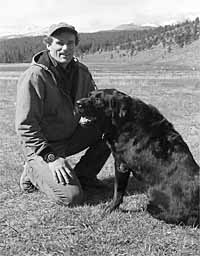Stanley wolves face uncertain summer
Conservationists fear Sawtooth pack could be next for lethal control
"If they have another year like they did last year, we’re
going to have some unfortunate control actions there."
- Biologist Curt Mack on the fate of the Stanley Pack
By GREG STAHL
Express Staff Writer
 Bill Leavell, a 12-year resident of the
Stanley basin, said he’s fond of listening to, and seeing, wolves in the Stanley
Basin. He’s afraid it’s only a matter of time, however, until the wolves get
into trouble with livestock on the Rocky Mountain Ranch, which he manages. Express
photo by Willy Cook
Bill Leavell, a 12-year resident of the
Stanley basin, said he’s fond of listening to, and seeing, wolves in the Stanley
Basin. He’s afraid it’s only a matter of time, however, until the wolves get
into trouble with livestock on the Rocky Mountain Ranch, which he manages. Express
photo by Willy Cook
This spring, five wolves from the White Cloud Pack were killed by the U.S.
Department of Agriculture’s Wildlife Services for preying on livestock in the East
Fork of the Salmon River. Members of the Twin Peaks Pack were killed this winter for
preying on cattle along the main Salmon River near Clayton.
Local conservationists fear the Stanley Pack will be next.
Until last year, the pack was one of the best behaved in Idaho.
But last summer, pack members preyed on three cow calves and 13 sheep,
according to Curt Mack, the Nez Perce Tribe’s wolf recovery leader. In response, one
wolf was shot by the U.S. Department of Agriculture’s Wildlife Services and another
was relocated to the Selway Bitterroot Wilderness Area.
Conservationists fear that the pack’s close proximity to summer
ranching will further antagonize the situation this summer.
Mack, a biologist, confirmed the validity of that concern.
"If they have another year like they did last year, we’re going
to have some unfortunate control actions there," he said. "They’ve been
such a good pack that we kept giving them fourth and fifth and sixth chances. If we
continue to have repeated depredations in the Stanley Basin, we won’t have a choice
but to go in and continue with control actions."
The Stanley Pack was founded by two of 20 wolves that were released by the
U.S. Fish and Wildlife Service in the Middle Fork of the Salmon River valley in 1996.
They were released as part of federal reintroduction efforts in
Yellowstone National Park, Montana and Idaho in 1995 and 1996. Thirty-five wolves, in all,
were relocated from Canada to Idaho.
According to Lynne Stone, director of the Ketchum-based Boulder-White
Cloud Council, a conservation group, federal decision making on wolf control actions in
the Salmon River corridor this winter don’t give wolf supporters much confidence in
future management of the Stanley Pack.
"I’m concerned that they stay standing and breathing," she
said in an interview last week.
Stone said that of all known wolf packs in Idaho, the Stanley pack is in
the most peril because of the close quarters it keeps with ranching.
Mack concurred.
Consequently, the Boulder-White Cloud Council and other Northwest
conservation groups joined late in April to ask the U.S. Fish and Wildlife
Service—the federal agency responsible for wolf recovery—that lethal control no
longer be used on wolves preying on livestock in Idaho.
"We’re asking for a cease-fire before the Stanley wolf pack is
killed off, too," Stone wrote in an April press release. "The agency keeps
shooting wolves to appease ranchers. We’ve asked for a moratorium before we lose all
the wolves in the Sawtooth National Recreation Area and nearby Challis Forest."
However, the rules under which wolves were reintroduced to Idaho
won’t allow such a cease-fire, said Roy Heberger, U.S. Fish and Wildlife Service
Idaho wolf recovery leader.
Such action would require altering the federal regulations, he said, which
would be a long process.
But unless that occurs, Stone said, she is not encouraged by what she
perceives as a hostile wolf environment in Custer County, an environment she claims is at
the root of wolf-related problems in Idaho.
"There’s enough hostility in Stanley and other parts of Custer
County that I wouldn’t be surprised if something ugly happens," she said.
#
 This is a wolf track, found in fresh snow in the White Cloud
Mountain foothills Friday. It was among many spotting the snow that day. Express
photo by Willy Cook
This is a wolf track, found in fresh snow in the White Cloud
Mountain foothills Friday. It was among many spotting the snow that day. Express
photo by Willy Cook
Members of the Stanley wolf pack have been hanging around the mid-Stanley
Basin all winter, feeding on elk that winter in the lowlands near the Salmon River.
At present, they’re roaming the foothills of the White Cloud
Mountains, and the alpha female, B23F, is probably denned in the hills with a litter of
pups while her mate, B27M, gathers food, Heberger said.
According to Mack, this is the Stanley pack’s story:
The pack became a bona fide wolf pack in 1997 when B23F gave birth to a
litter of six.
Most of that year, the Stanley pack inhabited the northern part of the
Stanley Basin around Valley Creek.
Following that year, pack members began to disperse to other packs or
locations and the pack structure "loosened" a bit, Mack said, meaning that
different pack members were located in different parts of the Stanley Basin.
To date, dispersing members have gone north to the mouth of the Salmon
River, east to near Challis and south to the Copper Basin.
In 1998, the alpha female whelped about a half dozen more pups, and by
mid-summer the pack was confirmed to consist of 13 to 16 members. Mack said the pack was
at that time, and continues to be, one of the largest in Idaho.
Last spring, the alpha female had seven more pups.
During the ensuing summer, one pack member was killed by Wildlife Services
and another was relocated for preying on livestock.
And that brings the pack’s story to the present. The alpha female is
likely raising pups yet again, and the pack is preying on elk that are still limited to
valley floors because of high-mountain snowpacks.
Sheep and cattle will arrive in the area for summer grazing in about three
weeks, and Mack said the wolves will be monitored closely to ensure that they don’t
continue to prey on livestock.
#
Don Sessions has operated Sessions Lodge and convenience store in
Obsidian, south of Stanley, for 30 years. He’s not happy about the presence of wolves
in the Stanley basin, he said at his store Friday.
"If you can tell me one thing we gain from having wolves here, I
might change my mind," he said.
Knowing wild gray wolves are alive and well in a wild Idaho isn’t
enough, he said.
"I can’t for the life of me see why they wanted them down here
to begin with," he said. "I’ve got nothing against the wolves. It’s
just the taxpayer money."
Sessions, like others who speak out against wolves in Idaho, says the
money the federal government is spending on wolf recovery is inappropriate.
According to Heberger, Congress has spent over $2 million on wolf recovery
to date, not including actual reintroduction and relocation costs associated with the 1995
and 1996 releases.
In response to Sessions’ argument against taxpayers’ funding
wolf recovery, he said that wolves, like any political issue, are the result of "this
200-year experiment in democracy."
If Sessions has a problem with it, he should write his congressman,
Heberger said.
#
Bill Leavell, a 12-year resident of the Stanley Basin, has seen and heard
wolves near his rustic cabin beside the Salmon River all winter. In an interview at his
home Friday, he said he straddles the fence between opposing opinions on wolf
reintroduction in Idaho.
"I certainly understand both sides of the issue," he said.
"People (ranchers) work really hard for their livelihoods, but I love to see and
listen to them."
The 45-year-old Leavell is manager of the Rocky Mountain Ranch, a guest
ranch about nine miles south of Stanley.
The ranch leases portions of its land to downstream ranchers for livestock
grazing in the summer. That will begin in mid-June, he said, pointing out that his
comments on wolves are his opinions, not those of the ranch’s owners, who wish to
remain anonymous.
Leavell hasn’t had problems with wolves on the land he manages, but
he doesn’t wear blinders to the possibility.
"You have this huge prey base (cattle) that just pops in the valley
from time to time, and the wolves are opportunists, it appears," he said. "I
imagine it’s just a matter of time."
Beyond a concern as the ranch’s manager and overseer for summer
livestock, Leavell said he enjoys the presence of wolves.
"I haven’t had a sense of fear with them, but a sense of
curiosity," he said.
And amidst all the uproar and fanfare surrounding wolf recovery, Leavell
concluded:
"I don’t know where this thing’s going to head. I just know
the wolves are here and we have to deal with that."